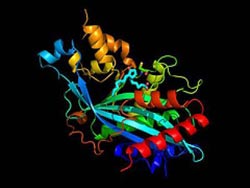Fish oil may hold key to leukemia cure

The compound shown above is D12-PGJ2, which closely resembles delta-12-protaglandin J3, or D12-PGJ3, a compound that targeted and killed the stem cells of chronic myelogenous leukemia, or CML, in mice during experiments conducted by Penn State researchers. According to the American Cancer Society, about 5,150 new cases of CML are reported annually and approximately 270 people die from the disease each year. Credit: Sandeep Prabhu<br>
The compound — delta-12-protaglandin J3, or D12-PGJ3 — targeted and killed the stem cells of chronic myelogenous leukemia, or CML, in mice, said Sandeep Prabhu, associate professor of immunology and molecular toxicology in the Department of Veterinary and Medical Sciences. The compound is produced from EPA — Eicosapentaenoic Acid — an Omega-3 fatty acid found in fish and in fish oil, he said.
“Research in the past on fatty acids has shown the health benefits of fatty acids on cardiovascular system and brain development, particularly in infants, but we have shown that some metabolites of Omega-3 have the ability to selectively kill the leukemia-causing stem cells in mice,” said Prabhu. “The important thing is that the mice were completely cured of leukemia with no relapse.”
The researchers, who released their findings in the current issue of Blood, said the compound kills cancer-causing stem cells in the mice's spleen and bone marrow. Specifically, it activates a gene — p53 — in the leukemia stem cell that programs the cell's own death. “p53 is a tumor suppressor gene that regulates the response to DNA damage and maintains genomic stability,” Prabhu said.
Killing the stem cells in leukemia, a cancer of the white blood cells, is important because stem cells can divide and produce more cancer cells, as well as create more stem cells, Prabhu said.
The current therapy for CML extends the patient's life by keeping the number of leukemia cells low, but the drugs fail to completely cure the disease because they do not target leukemia stem cells, said Robert Paulson, associate professor of veterinary and biomedical sciences, who co-directed this research with Prabhu.
“The patients must take the drugs continuously,” said Paulson. “If they stop, the disease relapses because the leukemia stem cells are resistant to the drugs.”
Current treatments are unable to kill the leukemia stem cells, Paulson noted. “These stem cells can hide from the treatment, and a small population of stem cells give rise to more leukemia cells,” said Paulson. “So, targeting the stem cells is essential if you want to cure leukemia.”
During the experiments, the researchers injected each mouse with about 600 nanograms of D12-PGJ3 each day for a week. Tests showed that the mice were completely cured of the disease. The blood count was normal, and the spleen returned to normal size. The disease did not relapse.
In previous experiments, the compound also killed the stem cells of Friend Virus-induced leukemia, an experimental model for human leukemia.
The researchers focused on D12-PGJ3 because it killed the leukemia stem cells, but had the least number of side effects. The researchers currently are working to determine whether the compound can be used to treat the terminal stage of CML, referred to as Blast Crisis. There are currently no drugs available that can treat the disease when it progresses to this stage.
The researchers, who applied for a patent, are also preparing to test the compound in human trials.
Media Contact
More Information:
http://www.psu.eduAll latest news from the category: Life Sciences and Chemistry
Articles and reports from the Life Sciences and chemistry area deal with applied and basic research into modern biology, chemistry and human medicine.
Valuable information can be found on a range of life sciences fields including bacteriology, biochemistry, bionics, bioinformatics, biophysics, biotechnology, genetics, geobotany, human biology, marine biology, microbiology, molecular biology, cellular biology, zoology, bioinorganic chemistry, microchemistry and environmental chemistry.
Newest articles

Properties of new materials for microchips
… can now be measured well. Reseachers of Delft University of Technology demonstrated measuring performance properties of ultrathin silicon membranes. Making ever smaller and more powerful chips requires new ultrathin…

Floating solar’s potential
… to support sustainable development by addressing climate, water, and energy goals holistically. A new study published this week in Nature Energy raises the potential for floating solar photovoltaics (FPV)…

Skyrmions move at record speeds
… a step towards the computing of the future. An international research team led by scientists from the CNRS1 has discovered that the magnetic nanobubbles2 known as skyrmions can be…





















